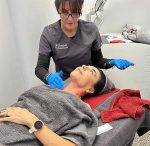The effects of the weight-loss drug semaglutide have made headlines over the last few years. So much so that the term “Ozempic face” is used across social media to describe the hollowed, sagging facial features that often result from losing a significant amount of weight while using GLP-1 agonist medications. The reality is, however, that this is simply the result of rapid weight loss, rather than the drug itself. Paola Chellew talks to Dr Cecile Baard to understand why “the face” occurs and whether anything can be done to avoid the negative aesthetic consequences of rapid weight loss in your face.

In the 21st century, the human race is caught up in its own race against time. Like fast food, we expect everything to be quick, whether it’s an Uber or scanning the news on X. Leisurely reading is a thing of the past; scrolling instead of strolling is the way to go. And when it comes to weight loss, we expect a quick fix instead of “slow and steady wins the race”.
Now, don’t get me wrong, we should hold science and its breakthroughs in high esteem, but we also need to start asking questions when sound science becomes misused or abused.
Thankfully, Dr Cecile Baard answers our burning questions.
Briefly explain how drugs like Ozempic (registered to treat type 2 diabetes) and Wegovy (registered to treat obesity) both lead to weight loss.
Dr Baard: Ozempic and Wegovy are the same drug (semaglutide) in different strengths or dosages. These medications help with weight loss by mimicking GLP-1 (glucagon-like peptide 1). This natural hormone is an appetite hormone primarily made in the digestive (gastrointestinal) tract. It targets the areas in your brain that regulate appetite, especially after eating. Semaglutide, therefore, suppresses the hunger cues in the brain.
It reduces blood sugar in diabetic patients, but, in the correct dosage, usually doesn’t affect the blood sugar of non-diabetic patients adversely.
Semaglutide delays emptying of the stomach and slows down digestion, which makes you feel fuller for longer.
However, if you do not follow a calorie-restricted diet, you will not lose weight.

What is “Ozempic face”?
Dr Baard: “Ozempic face” is a term used to describe the drastic facial changes (a gaunt or hollowed appearance) that many patients get after using Ozempic. It is not a medical term, but a term made popular by social media.
It refers to a hollowness of the cheeks or excess skin because of fat loss under the skin and in the face. Changes in the size of the chin, lips, and cheeks are visible; wrinkles are more pronounced, especially on the forehead and around the eyes and mouth; and the eyes can appear sunken. Dark under-eye circles can also develop. Sagging jowls and excessive skin in the neck are also signs of “Ozempic face”.
Do other weight-loss drugs have the same effect?
Dr Baard: Any rapid or significant weight loss, irrespective of the cause or method used, will have the same facial effects. It is not exclusive to Ozempic use. Rapid weight loss causes more loss of fat in the face.
Is it more noticeable in middle-aged patients?
Dr Baard: As we age, we lose skin elasticity, which means our skin does not have the same ability to bounce back after weight loss. Our skin is less able to adjust to changes. Reduced levels of collagen and elastin, which are essential for structural integrity, cause the skin to lose its capability to retract after rapid weight loss. Older patients are also more likely to have less skin elasticity due to lifestyle habits, like smoking, consuming excessive alcohol, and sun damage, in addition to skin type or genetics.
How does weight loss affect the skin?
Dr Baard: Facial fat has a protective function and contributes to the appearance of the face and skin elasticity. It helps to plump up or support the skin by providing an underlying structure. We see changes in the skin because the fat that cushions and stretches the skin is no longer in place.

How can you treat “Ozempic face”?
Dr Baard: The loss of fat in the face is not dangerous and doesn’t need treatment, but the facial effects of rapid weight loss will last indefinitely if left wholly untreated. There are many options, but each treatment comes with its own risks.
Dermal fillers are injections used to restore volume. There are several types of dermal fillers, so it’s best to have a consultation with your aesthetic doctor to discuss the best option. Results are typically immediate, with usually no or minimal downtime. There may be some bruising or slight swelling, as well as more serious side effects, if not done correctly. Facial filling can also be done with your own fat. This is called autologous fat grafting and should preferably be done by a plastic surgeon.
Microneedling with or without PRP (platelet-rich plasma) can be done to promote collagen and elastin stimulation. Microneedling is controlled trauma that activates the body’s own healing process – your inflammatory response. This will help keep your skin healthier, firmer, and smoother. It can help with the appearance of fine wrinkles and loose skin.
PRP involves taking your blood and spinning it in a centrifuge to separate the red blood cells from the plasma into platelet-rich and platelet-poor parts. Our platelets have growth factors that can trigger cell reproduction and tissue regeneration, or healing.
Energy-based skin tightening treatments usually have better outcomes in younger patients with good skin elasticity. These include Thermage, Ulthera, and Forma, among others.
Surgery may be an option if patients have exhausted other methods and are healthy enough and willing to undergo anaesthesia. Combining a facelift with fat transfer can both fill and lift the face.
How can you avoid “Ozempic face” other than by stopping the use of the drug altogether?
Dr Baard: Since “Ozempic face” is caused by rapid weight loss, slowing down the rate of weight loss will help. This can be achieved by either lowering the dose or using other medications. You can also discuss with your doctor whether a different drug may work better for you.
There are a few ways to stay healthy and maybe lessen some of these effects of weight loss on your skin:
- Hydration: Hydrated skin is much better at being able to return to its original shape after stretching or shrinking, so drink plenty of water.
- Diet: As semaglutide curbs your appetite, make sure you eat enough calories, so you do not accelerate the weight loss even more. Also, ensure that you eat enough protein. Protein helps to slow down lean body mass loss, and losing muscle is an unwelcome side effect of rapid weight loss. Basically, you need a well-balanced diet, even if you restrict calories. Eat antioxidant-rich fruits and vegetables, and limit or rather avoid refined sugar and processed foods.
- Lifestyle habits: Avoid smoking, as this affects collagen and elastin, and causes oxidative stress in the skin fibroblasts, which impairs collagen formation. It also reduces vitamin D production and can impair the body’s ability to absorb it. Vitamin D plays an important role in maintaining the skin barrier and helps with tissue repair.
- Skincare: Take care of your skin. Make sure you cleanse your face twice daily and keep it moisturised. Medical-grade skincare can improve skin quality and elasticity. It is important to use proper sun protection. A healthy, functional skin will have a better appearance.
Discuss adequate nutrition with your doctor and whether you should use certain supplements, especially iron and vitamin D.

Face facts
In short, if you are overweight, and this is affecting your health, then it’s a good idea to see your doctor or a nutritionist to help you achieve a healthy weight in a reasonable amount of time, support you on the way, and ensure that you minimise adverse effects like “Ozempic face”.
Paola Chellew is a freelance journalist and regularly writes for a number of publications. A former professional contemporary dancer, she has always loved the arts in all their forms. She has been a freelance writer for many years and has been published in various magazines including Live Out Loud, Private Life and Do It now magazines. Her passion for beauty and skincare started in her teens, when she would read every beauty editor’s picks and reviews. Serious about skincare, she has researched medical-grade products for over ten years, as well as aesthetic treatments to restore and repair skin to look its best. Having turned 60 last year, she has dedicated her blog to the “over 50s and beyond Club”, shining a spotlight on a generation that is seemingly side-lined by the beauty industry. “There is no age limit for when you stop being beautiful – a gorgeous lipstick, a sexy fragrance, radiant skin- these are not synonymous with youth- they are just things that add an extra sparkle to my day”.
📸 Profile photo credited to Lerissa Kemp Photography
MBChB (Pret), Adv Dip Aesthetic Med (FPD)
Dr Cecile Baard is a GP with special interest in Aesthetic, Cosmetic and Rejuvenative Medicine. She obtained her MBChB in 1995 at the University of Pretoria and the Advanced Diploma in Aesthetic Medicine cum laude in 2018 at the Foundation of Professional Development.
She is involved with medical weight loss since 2007, worked in Aesthetic Medicine since 2010 and established Dr Cecile Baard Aesthetics in 2016. Dr Baard also consults for Hair Clinic International, performing regenerative medical procedures for hair restoration. She regularly attends international and local congresses and aesthetic courses to stay abreast of the most up to date non-surgical cosmetic and anti-aging procedures. She is a member of the South African Medical Association (SAMA), Aesthetic and Anti-Aging Medicine Society of South Africa (AAMSSA) and Complications in Medical Aesthetics Collaborative (CMAC).







